The AMD Ryzen 9 7950X3D Review: AMD's Fastest Gaming Processor
by Gavin Bonshor on February 27, 2023 9:00 AM ESTCPU Benchmark Performance: Power And Office
Our previous sets of ‘office’ benchmarks have often been a mix of science and synthetics, so this time we wanted to keep our office section purely on real-world performance. We've also incorporated our power testing into this section too.
The biggest update to our Office-focused tests for 2023 and beyond include UL's Procyon software, which is the successor to PCMark. Procyon benchmarks office performance using Microsoft Office applications, as well as Adobe's Photoshop/Lightroom photo editing software, and Adobe Premier Pro's video editing capabilities. Due to issues with UL Procyon and the video editing test, we haven't been able to properly run these, but once we identify a fix with UL, we will re-test each chip.
We are using DDR5 memory on the Ryzen 9 7950X3D and the other Ryzen 7000 series we've tested. This also includes Intel's 13th and 12th Gen processors. We tested the aforementioned platforms with the following settings:
- DDR5-5600B CL46 - Intel 13th Gen
- DDR5-5200 CL44 - Ryzen 7000
- DDR5-4800 (B) CL40 - Intel 12th Gen
All other CPUs such as Ryzen 5000 and 3000 were tested at the relevant JEDEC settings as per the processor's individual memory support with DDR4.
Power
The nature of reporting processor power consumption has become, in part, a bit of a nightmare. Historically the peak power consumption of a processor, as purchased, is given by its Thermal Design Power (TDP, or PL1). For many markets, such as embedded processors, that value of TDP still signifies the peak power consumption. For the processors we test at AnandTech, either desktop, notebook, or enterprise, this is not always the case.
Modern high-performance processors implement a feature called Turbo. This allows, usually for a limited time, a processor to go beyond its rated frequency. Exactly how far the processor goes depends on a few factors, such as the Turbo Power Limit (PL2), whether the peak frequency is hard coded, the thermals, and the power delivery. Turbo can sometimes be very aggressive, allowing power values 2.5x above the rated TDP.
AMD and Intel have different definitions for TDP that are, broadly speaking, applied the same. The difference comes from turbo modes, turbo limits, turbo budgets, and how the processors manage that power balance. These topics are 10000-12000 word articles in their own right, and we’ve got a few articles worth reading on the topic.
- Why Intel Processors Draw More Power Than Expected: TDP and Turbo Explained
- Talking TDP, Turbo and Overclocking: An Interview with Intel Fellow Guy Therien
- Reaching for Turbo: Aligning Perception with AMD’s Frequency Metrics
- Intel’s TDP Shenanigans Hurts Everyone
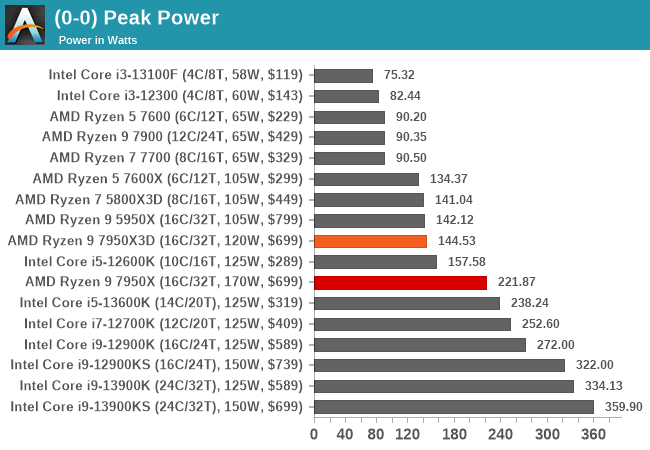
Given that the Ryzen 9 7950X3D has a lower TDP and PPT rating than the Ryzen 9 7950X, it pulls less power. We observed a peak power output of 144.53 W on the 7950X3D, compared to 221.87 W on the 7950X. Talking figures, the Ryzen 7950X3D is pulling around 65% of the power of the 7950X, which is understandable given the power limitations due to the CCX laden with AMD's 3D V-Cache packaging.
Looking at the power consumption of the Ryzen 9 7950X3D in closer detail, we can see that it delivered a consistent load of between 140 and 144 W in our Prime95 sustained power test. This is around 18 Watts lower than the official Package Power Tracking (PPT) level AMD has set at 162 W. However, it operates higher than the TDP of 120 W, which is to be expected. The TDP and PPT ratings are different as the TDP is the base power the CPU should be drawing, while the PPT (socket), set at 162 W, is the maximum the processor can draw as a maximum under full load.
Office/Web
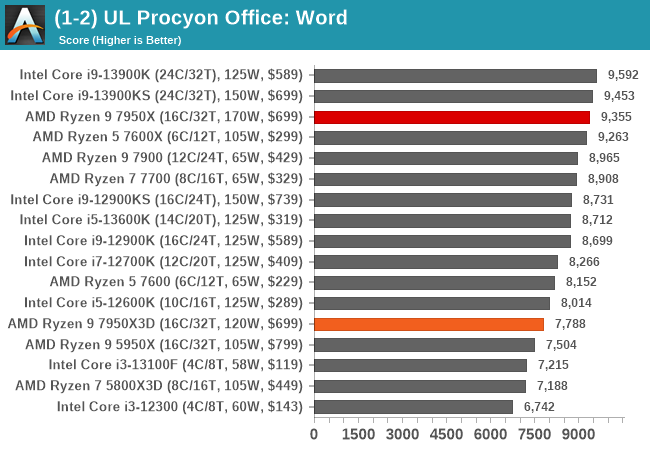
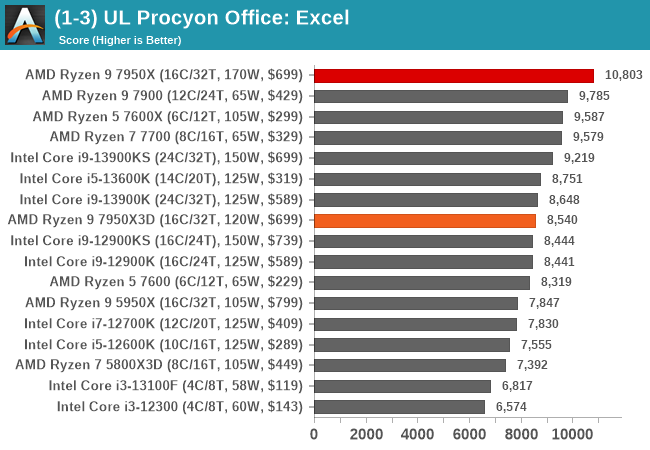
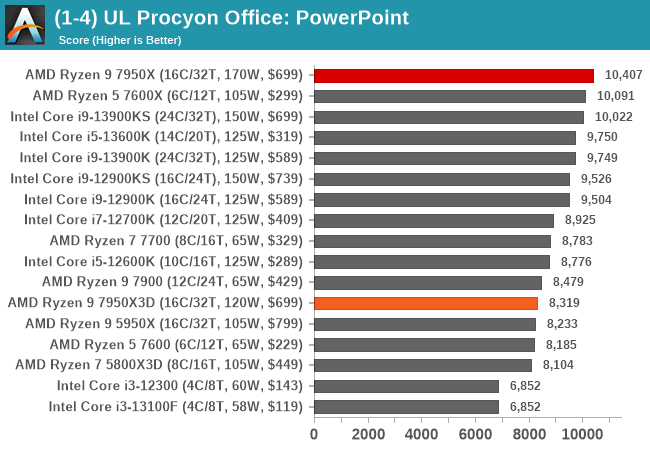
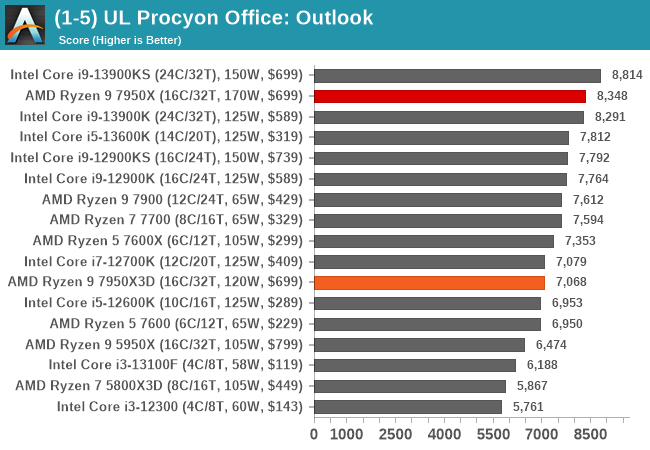
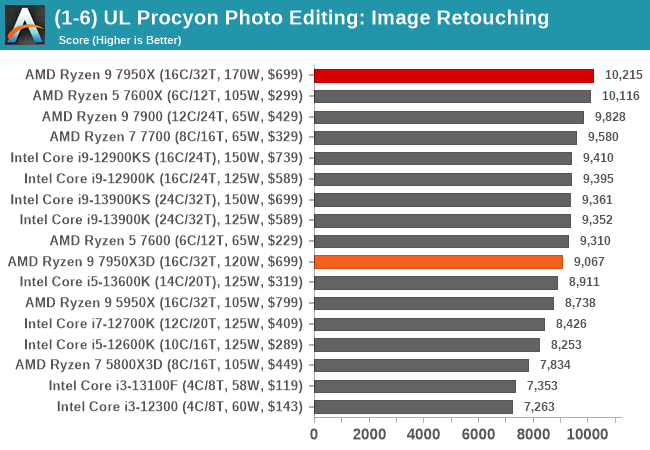
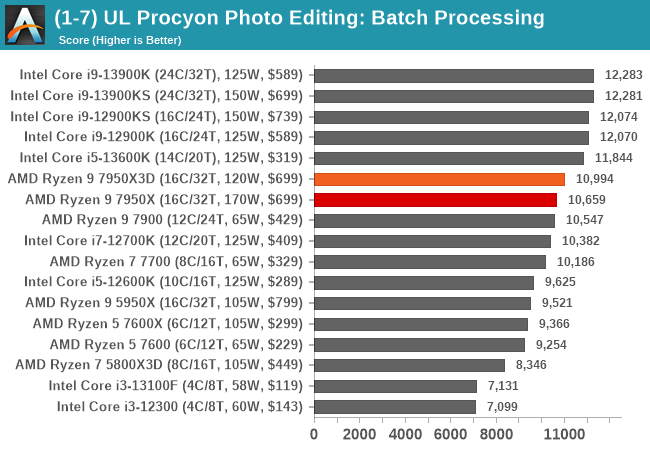
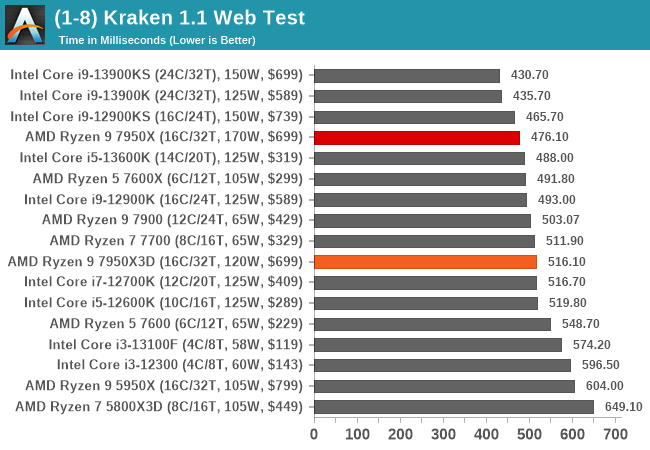
In our office-based testing, the Ryzen 9 7950X3D performs a little worse than the 7950X, but this is to be expected given the differences in TDP, PPT, and the overall power envelope. Still, the 7950X3D performs well and is more than suitable for office and web-based tasks.


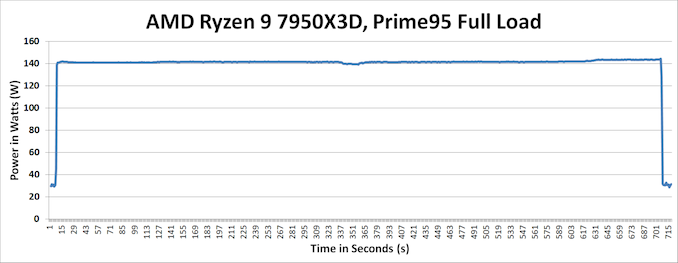








122 Comments
View All Comments
Silver5urfer - Wednesday, March 1, 2023 - link
Forgot to mention. Why AMD is doing this much of BS Windows level Drivers ? I honestly expect AMD to engineer and in CPU solution like Intel Thread Director. Relying on Windows BS is all but nonsense. Esp Windows 10 is a mess with WaaS and Win11 its a disaster with all the shenanigans and downgrades to Win32 Shell.LTSC is only worth on Windows 10 and forcing Xbox Game Bar mode is pathetic. Another red flag. Also in case if anyone does not know, AMD Zen 4 works on Windows 7 but with these changes to Chipset driver I think it might be a head ache not worth. Winraid forum has details how to Install 7 onto your new HW. I did with Intel Comet Lake 10th gen. Last good Windows OS and however Windows 10 LTSC 1809 / 21H2 are now better version for gaming and other modern software workloads. 11 is a failure and not worth time.
Oxford Guy - Wednesday, March 1, 2023 - link
'AMD processors are not good for tinkerers'That's not a loss. CPUs are supposed to be advanced-enough with modern turbo and other modes that the anachronistic tinkering isn't needed.
It reminds me of the death of the manual shifter. DSGs have better fuel economy, the one major thing left in the manual advocate's list of talking points.
Overclocking is still useful for one thing: people who make money via the overclocking industry.
Silver5urfer - Thursday, March 2, 2023 - link
I don't like AMD clock behavior for Zen 3 so I did not pick it add the buggy IODie they had. Zen 4 is very fast and scales with Temp. So I can choose Zen 4 over RPL (as RPL has E core garbage and LGA socket engineering flaw). But Tinkering is fun to me, controlling 100% of your CPU is interesting and with Intel you get high clock rate stick for all workloads.GPUs are boring because of that.
Jp7188 - Thursday, March 9, 2023 - link
Initially I preferred Intel overclocking and was frustrated with poor (or negative) gains on Zen3. It took me a while to get my process down for curve optimization overclocking, but once I did I had great fun in overclocking Zen 3. It is by far the most elegant overclocking system and favored core(s) is scheduled well by Windows. Contrast that with Intel's latest which I have not found to be as satisfying to tinkering with and P/E core scheduling isn't perfect.I haven't put hands on 7000x3d, but I'm not looking forward to another heterogenous core design. I will hold out hope that AMD can hit high clocks with extra cache for the 8000 series. It is my feeling that the 7nm cache slice doesn't clock as well as the 5nm ccd and requires more voltage - which are holding back performance in order for AMD to save a couple of bucks.
blkspade - Wednesday, March 22, 2023 - link
Yes V-cache in consumer uses target gamers. It's silly to think people that care about games, are only gamers. The 1st thing to accept that is that a $700 CPU already isn't for a lot of people. Nor was a $800 5950X. You can be a gamer, with a wide range of computer uses that makes the density make sense. What do you do when actually have use for a CPU like a 5950X, and play games where the 5800X3D basically demolishes it in a meaningful way? MSFS, Star CItizen, and DCS particularly in VR, benefit tremendously from the cache. A 5950X can be a bottleneck to even a 6800XT in those cases. You'd probably want a v-cache part, without giving up your threads. The 7950X3D exists for those users.Jdogdarkness - Wednesday, March 1, 2023 - link
I find Anandtech very good, but honestly this review feels like THE INTENT was to handicap v cache chips. They used the worse ram they could find. Didn't even use recommended. Kinda disappointingGavin Bonshor - Thursday, March 2, 2023 - link
We test at JEDEC settings as a matter of principle and consistency. If I used DDR5-6000 on the X3D (sweet spot according to AMD) but then I used DDR5-7000 on Intel's 13th Gen, the results wouldn't be comparable.Using JEDEC settings allows us to consistently measure data via the manufacturer's specifications. Using XMP/EXPO is overclocking, and we've, for as long as I can remember, used JEDEC, and we will continue to do so.
silverblue - Friday, March 3, 2023 - link
The 3D chips appear to be far less memory-sensitive than the standard Zen 4 offerings. The handicapping generally appears to be down to a suboptimal method of detecting whether a "game" is running; I'm wondering whether cache usage or even application profiles would've made for a better metric, that way your CS:GOs and other high FPS games would get shunted off to the higher frequency cores where they belong.MrPhilo - Friday, March 3, 2023 - link
Questionable RAM speed was used for both Intel and AMD, especially AMD.GruiaL - Sunday, March 5, 2023 - link
AMD saw that people are buying Intel chips, with those silly efficiency cores, which are useless in gaming, so they did the same.7950x3D has 8 parked cores in games. This means that Intel's higher frequency=AMD v-cache. You can either process more information faster, or you can keep it close by in that v-cache buffer, for faster access. Results are the same.
Difference is, the latter sucks up less energy.
I bet the 7800x3D is going to perform the same in games like the 7950x3D, which is the same as the 13900K. The nice thing is the cost on that chip.